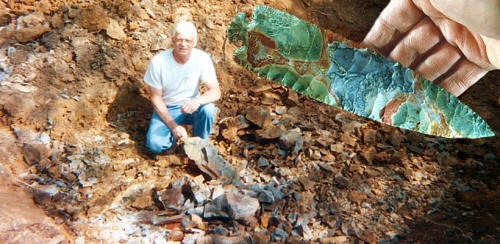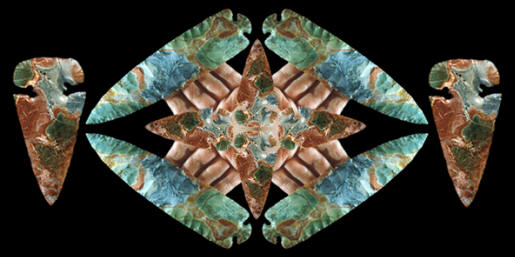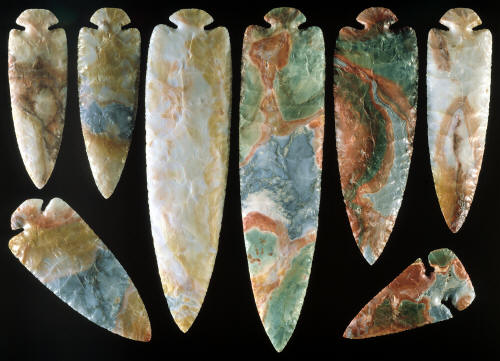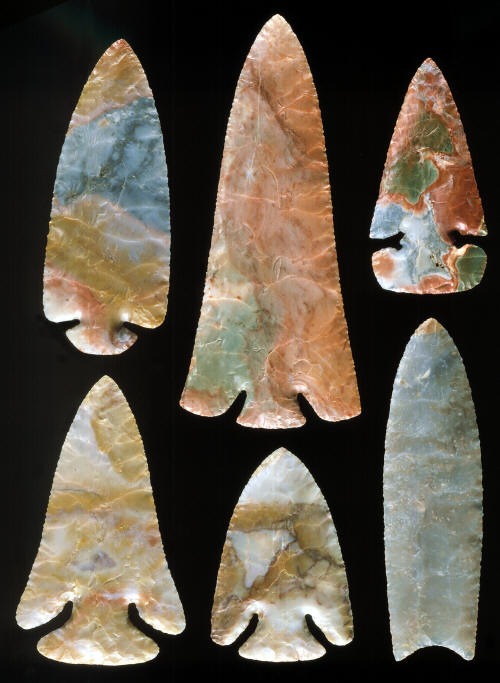|
||
|
||
|
ROY MILLER "Roy is well known across the country for his incredible pieces made from Flint Ridge, with the button-base (Dovetails) being his forte."---------2000, by Chips staff, "Chips, Vol. 12. #1," p. 11. "He (Roy Miller) has instructed numerous people (at knap-ins) and has been an inspiration to many others."---------2000, by Chips staff, "Chips, Vol. 12. #1," p. 11. "Although well known for his buttons (Dovetails), Roy is very well accomplished at making a long and impressive list of types (of points)."---------2000, by Chips staff, "Chips, Vol. 12. #1," p. 11. FLINT RIDGE QUARRY "One of the greatest of the known aboriginal quarries is located on what is commonly called Flint Ridge, a narrow irregular plateau-capped line of hills in licking and Muskingum Counties, Ohio."---------1919, by W. H. Holmes, "Handbook of Aboriginal American Antiquities," Part I "Introductory The Lithic Industries," Smithsonian Institution, bulletin 60, p. 173-181.
"The extent of
the ancient operations (at the Flint
Ridge quarries) is almost beyond
belief and can be realized only imperfectly by those who have not
visited the locality."---------1919,
by W. H. Holmes, "Handbook of Aboriginal American Antiquities,"
Part I "Introductory The Lithic Industries," Smithsonian Institution,
bulletin 60, p. 173-181.
If there is any one person who's name immediately conjures up colorful stone it's Roy Miller. That's because, as a flintknapping artist, his canvas is made of some of the most colorful stone in the world, Flint Ridge flint. Roy has an advantage over other knappers because, a few years ago, he bought several acres of the ancient Flint Ridge quarry in Licking County, Ohio. His land has produced some of the most colorful pieces of Flint Ridge flint that has ever been seen and he is putting it to good use. |
||
|
Roy Miller grew up in an Amish family. So he was close to the land at an early age. He says he found his first flint point at the age of nine, when he was helping to plow a field with a team of horses. He says "He was captivated by the idea that an Indian, thousands of years ago, probably fashioned that point as a tool." |
||
|
Roy began surface collecting Ohio farm fields at an early age. His interest in ancient stone artifacts set him on a path that really began in 1980 when he started to experiment with flintknapping. He experimented on his own with nails, screwdrivers, pliers and hammers before he acquired a copy of D. C. Waldorf's "The Art Of Flintknapping." It took many years of hard work and practice to arrive where he is today, as one of the few highly skilled lithic artisans in the country. |
||
|
Roy has been attending knap-ins and promoting lithic art for many years. He's been involved with the Flint Ridge knap-in since the mid 1980's. In "Chips" under the "Knapper Profile" they write "He loves knap-ins, meeting people, and all the fun that he has with the craft. He is quick to pass out good information and knapping tips. He has instructed numerous people and has been an inspiration to many others." |
||
| CONTINUE ON TO PAGE TWO | ||
|
"REFERENCES"
1892, Moorehead, Warren K., "Primitive Man In Ohio," p. 31. |
||





